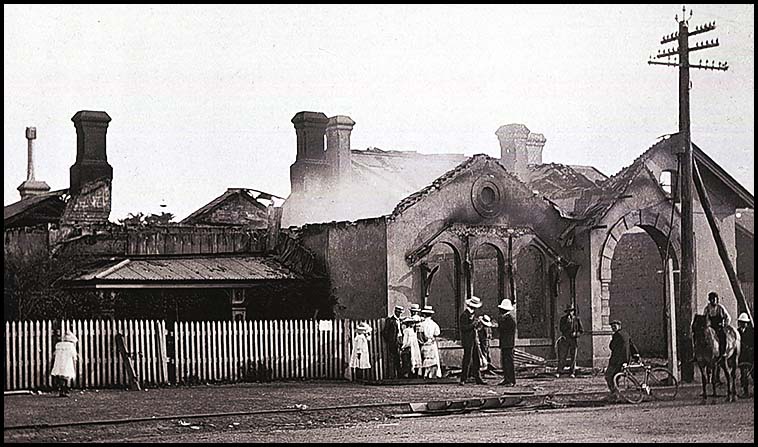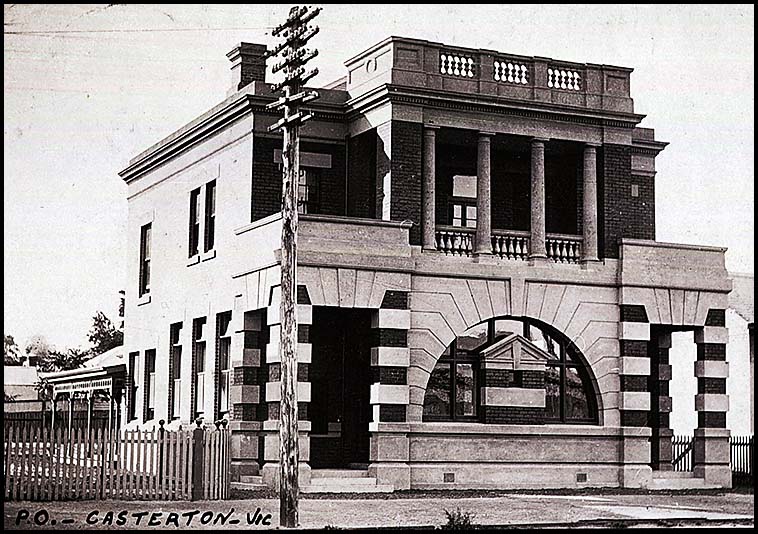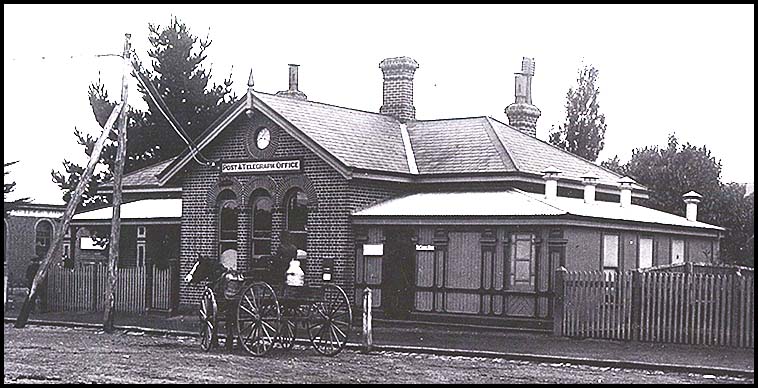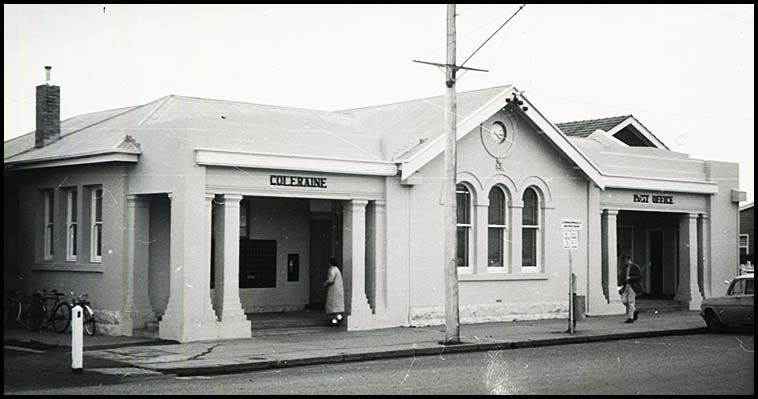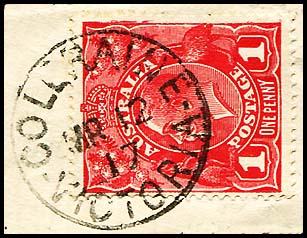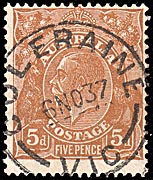Telegraph Offices on the Penola Line (No. 7 West).
- Australia 1901-1988
- New South Wales
- Queensland
- South Australia
- Tasmania
- Victoria
- Western Australia
- International
- Special aspects
The following Telegraph Offices are accessed from this page:
| Ballarat | Branxholme | Caramut | Casterton | Coleraine |
| Hamilton | Heywood | Hexham | Merino | Mortlake |
| Penola | Penshurst | Portland |
|
The Telegraph Office was opened in March 1874. The Post Office was originally opened as Muston's Creek but became Carramut on 1 January 1852. No special date stamp was issued for telegram use. |
| Casterton. The Telegraph Office was opened in July 1865. It was part of the extension of the inter-colonial line from Penola in South Australia to Victoria. In August 1872, a deputation was asking the Postmaster-General to construct a new telegraph Office. In February 1873, the Ballarat Star commented that the tender had just been readvertised and the closing date had also been extended by an additional fortnight. It noted that it was difficult to obtain building companies and contractors because of the very significant amount of development going on in Hamilton. A Telegraph Office was also opened at the Railway Station about 1910. It was reclassified as a Post Office in 1915 and closed in the following year. A Telegraph Office was also opened at Casterton Racecourse in 1933. It only operated on race days. The Office closed in 1970. |
|
|
|
|
The office was issued with two date stamps for use with telegraphs:
|
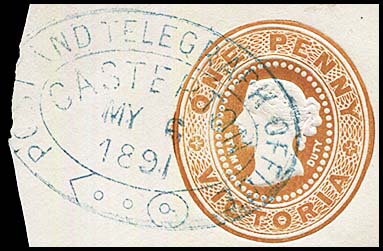 |
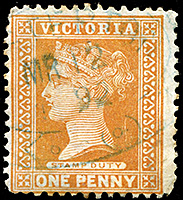 12 March 1892. 2 hole in blue. |
|
|
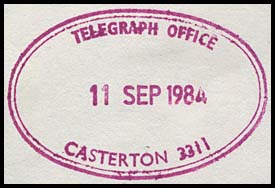 11 September 1984. |
| Coleraine.
The Telegraph Office was opened (not without effort) in August 1867. In 1910, a Telegraph Office was opened at the Railway Station. It was reclassified as a Post Office in 1915 but it was closed in 1916. |
|
|
In the Legislative Assembly of 10 February 1864, Mr Mollison gave notice that he would, ask the hon. the Chief Secretary, with respect to the extension of telegraphic communication from Hamilton to Casterton, promised to be undertaken during the present year, whether provision had been made to make the intermediate town of Coleraine a telegraph station. On 22 February 1865, the Hamilton Spectator addressed the issue of the need for a Telegraph Office at Coleraine on the line from Hamilton to Casterton:
The Coleraine Telegraph Station was a guaranteed Office to the extent of £130 per annum. Details of the guarantee and the Revenue and Expenditure for 1867 are included in the McGowan Report for 1867 (p. 5). Just a short three and a bit years after McGowan's visit to Coleraine, " the inhabitants are bestirring themselves to memoralise the Government to erect government buildings in their rising township. The buildings now used as Post and Telegraph offices, Court House and lock-up are quite unsuitable and inadequate. The latter is so insecure that more than one prisoner has escaped". (The Age, 7 August 1868). OBITUARY: We regret to record the death of Mr. Edward Banks of the Post and Telegraph department, a gentleman who, a few months ago, performed his duty at Coleraine until relieved by the Post and Station-Master, Mr. Salkeld. Mr. Banks was a victim to pulmonary consumption and, at the time of his death, he was residing at Camberwell, near Melbourne, on sick leave. He had been in the service over fifteen years and he was only thirty three years of age". |
Coleraine was issued with a 1 hole Belt & Buckle date stamp.
|
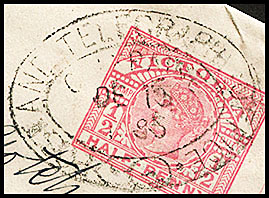 15 December 1893. Latest recorded date. |
| ½d wrapper sent to Gordon & Gotch in Melbourne from Coleraine on 15 December 1893. | 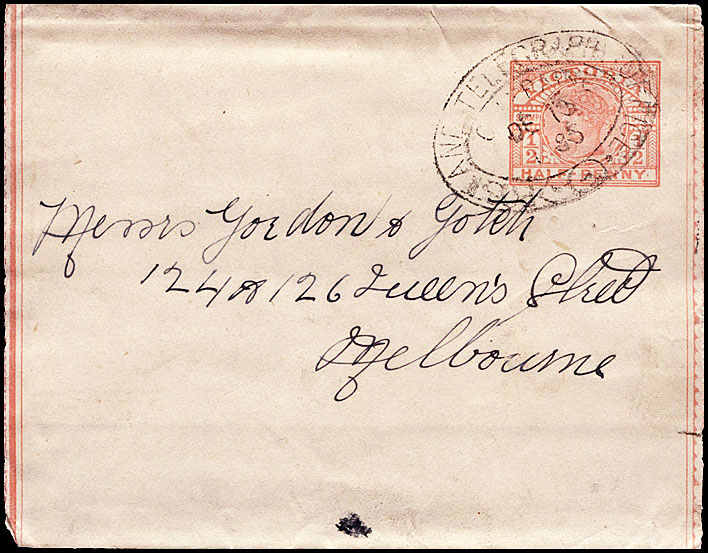 |
| Two common date stamps used postally and on telegrams.
Left: Type 50 (left); Right: Type 60. |
|
|
Condah Railway Station. A Telegraph Office was opened in August 1878 - not "about 1911" as reported in Watson et al. |
|
The Telegraph Office opened in March 1861 due to the lack of funds for building the Telegraph Office. Mr William Shields was appointed as the assistant in charge of the Electric Telegraph and he was also to be a Collector of Imposts. In the 4 October 1861 Gazette, William Shields was transferred to be Manager of the Telegraph Office and Postmaster at Wangaratta from 12th August, 1861. He was replaced at Hamilton by William Weston who was appointed as operator in charge of the Telegraph Office from 12th of August, 1861. On 9 May 1929, the Postmaster-General announced the decision to provide a "start stop" machine printing duplex telegraph system for messages between Melbourne and Hamilton. When the transmitter key was pressed at one location, the letter would be printed at the other. |
||
 Hamilton Post and Telegraph Office about 1910. |
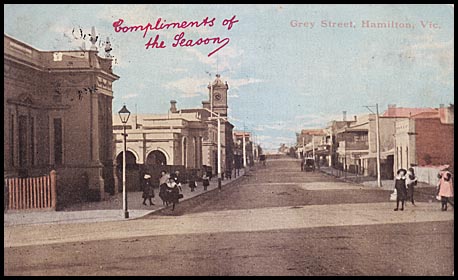 General view of Grey Street showing Post & Telegraph Office a few hundred yards on the left. |
|
| The earliest evidence of the operation of the Hamilton Telegraph Office is a telegram delivery envelope shown below used at Hamilton Telegraph Office to mail a message to Hochkirch on 5 February 1883. |
A 1 hole Belt & Buckle date stamp was issued to the Telegraph Office.
|
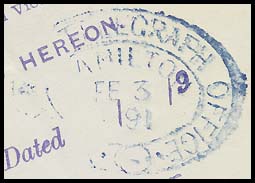 3 February 1891 (latest recorded date). Used on VC-DO-13. |
| 5 February 1883 - earliest recorded date for use of the Belt & Buckle in blue at any Telegraph Office.
Hamilton to Hochkirch. |
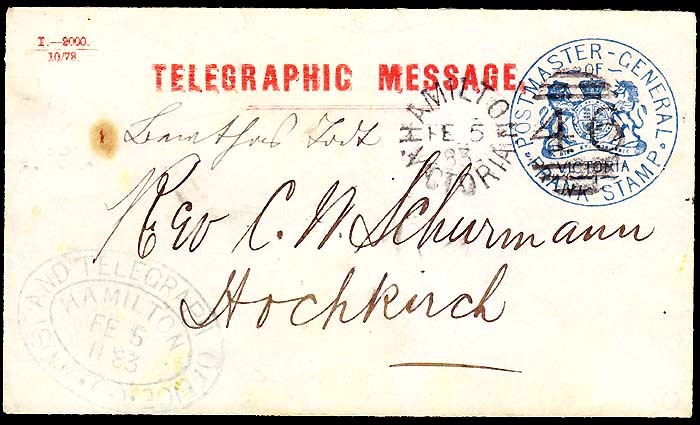 5 February 1883. |
||
| Hamilton to Sydney. 22 November 1890. Rare use of two blue Hamilton Belt & Buckle date stamps on an inter-colonial letter - only two covers are recorded with a Belt & Buckle date stamp which have ben sent to another Australian Colony.. |
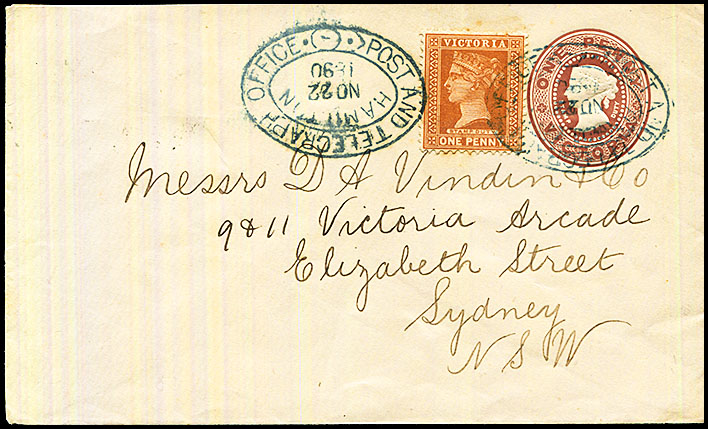 22 November 1890. |
||
|
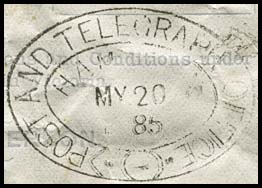 20 May 1885. |
|
Heywood. The Telegraph Office was opened in July 1877. |
||
| Hexham.
The Telegraph Office was opened in April 1858 when Hexham formed part of the first line to South Australia. Tenders for the erection of the Telegraph Office at Hexam were let in December 1857 to Thomas Harper for £630. Harrow is amongst the oldest inland settlements in Victoria. |
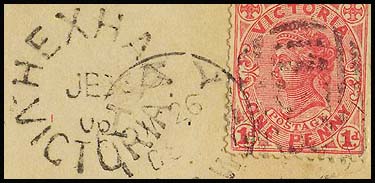 |
|
The Telegraph Office opened in May 1879. |
||
|
The Telegraph Office was opened on 17 June 1864. Prior to this its name was Mount Shadwell. On 21 January 1875, the Camperdown Chronicle announced "We regret to hear of the death of Mr. John Hayes, late Post and Telegraph Master at Mortlake, which, occurred at Warrnambool on the 13th instant. For the past twelve months he has been on leave of absence on account of ill-health which was partly brought on by an accident that he met with about two years ago while performing a feat at the athletic sports which he took great interest in. The deceased leaves a large circle of friends to mourn his loss". |
| Penshurst.
The Telegraph Office was opened in January 1867. The Penshurst Telegraph Station was a guaranteed Office to the extent of £150 per annum. Details of the guarantee and the Revenue and Expenditure for 1867 are included in the McGowan Report for 1867 (p. 5). Tenders were invited on March 1877 for the "erection in stone of a combined Post and Telegraph Office combined with a Court House at Penshurst". |
||
| The Office was issued with a 1 hole Belt & Buckle date stamp.
|
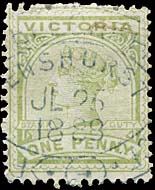 25 July 1888. (earliest recorded date). |
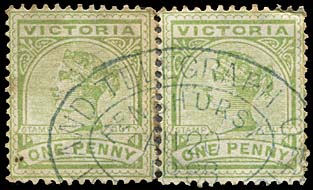 20 August 1888. |
